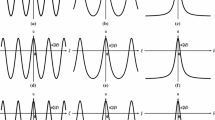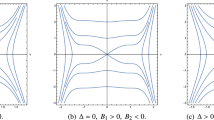Abstract
This paper is devoted to the existence and bifurcations of positive periodic solutions of nonlinear differential equation related to the Liebau phenomenon in rigid pipe-tank flow configuration. We obtain some more general requirements on the existence of a positive harmonic solution which improves the results in literatures. It is revealed that the system undergoes saddle node bifurcation, period doubling bifurcation and Neimark–Sacker bifurcation generating various periodic solution of different stability types. The multiplicity of both the positive harmonic solution and positive second-order subharmonic solution is first detected in this equation by numerical bifurcation analysis. Moreover, this work reveals that the positive subharmonic solutions of the nonlinear differential equation will also lead to the Liebau phenomenon in the model.







Similar content being viewed by others
Data availability
The datasets generated during and/or analyzed during the current study are available from the corresponding author on reasonable request.
References
Liebau, G.: Über ein ventilloses Pumpprinzip. Naturwissenschaften 41, 327 (1954)
Liebau, G.: Die bedeutung der tragheitskrafte fur die dynamik des blukreislaufs. Zs Kreislaufforschung 46, 428–438 (1957)
Männer, J., Wessel, A., Yelbuz, T.M.: How does the tubular embryonic heart work? Looking for the physical mechanism generating unidirectional blood flow in the valveless embryonic heart tube. Dev. Dyn. 239(4), 1035–1046 (2010). https://doi.org/10.1002/dvdy.22265/full
Cid, J., Propst, G., Tvrdý, M.: On the pumping effect in a pipe/tank flow configuration with friction. Phys. D 273–274, 28–33 (2014)
Cid, J., Infante, G., Tvrdý, M., Zima, M.: A topological approach to periodic oscillations related to the Liebau phenomenon. J. Math. Anal. Appl. 423, 1546–1556 (2015)
Cid, J., Infante, G., Tvrdý, M., Zima, M.: New results for the Liebau phenomenon via fixed point index. Nonlinear Anal. Real World Appl. 35, 457–469 (2017)
Liao, F.: Periodic solutions of Liebau-type differential equations. Appl. Math. Lett. 69, 8–14 (2017)
Propst, G.: Pumping effects in models of periodically forced flow configurations. Phys. D 217, 193–201 (2006)
Perko, L.: Differential equations and dynamical systems. Springer-Verlag, New York (1991)
Torres, P.: Mathematical models with singularities, a zoo of singular creatures. Atlantis Press, Paris (2015)
Guo, D., Lakshmikantham, V.: Nonlinear problems in abstract cones. Academic Press, Boston (1988)
Doedel, E., Paffenroth, R., Champneys, A., Fairgrieve, T., Kuznetsov, Y., Oldeman, B., Sandstede, B., Wang, X.: AUTO2000: Continuation and Bifurcation Software for Ordinary Differential Equations available via (2000). http://cmvl.cs.concordia.ca/auto/
Kuznetsov, Y. A.: Elements of applied bifurcation theory. Springer Science & Business Media, (2013)
Barraquand, F., Louca, S., Abbott, K.C., et al.: Moving forward in circles: challenges and opportunities in modelling population cycles. Ecol. Lett. 20, 1074–1092 (2017)
Ren, J., Yuan, Q.: Bifurcations of a periodically forced microbial continuous culture model with restrained growth rate. Chaos 27, 083124 (2017)
Rego-Costa, A., Debarre, F., Chevin, L.M.: Chaos and the (un)predictability of evolution in a changing environment. Evolution 72, 375–385 (2018)
Benincà, E., Ballantine, B., Ellner, S.P., et al.: Species fluctuations sustained by a cyclic succession at the edge of chaos. Proc. Natl. Acad. Sci. 112(20), 6389–6394 (2015)
Wang, F., Cid, J., Zima, M.: Lyapunov stability for regular equations and applications to the Liebau phenomenon. Discrete Contin. Dyn. Syst. A 38, 4657–4674 (2018)
Krauskopf, B., Osinga, H., Galán-Vioque, J.: Numerical continuation methods for dynamical systems. Springer, (2007)
Cheng, Z.B., Gu, L.L.: Positive periodic solution to a second-order differential equation with attractive-repulsive singularities. Rocky Mt. J. Math. 52, 77–85 (2022)
Dalbono, F., Rebelo, C.: Poincaré-Birkhoff fixed point theorem and periodic solutions of asymptotically linear planar Hamiltonian systems. Turin fortnight lectures on nonlinear analysis (2001). Rend. Sem. Mat. Univ. Politec. Torino 60(4), 233–263 (2002)
Funding
Funding was provided by Technological Innovation Talents in Universities and Colleges in Henan Province (Grant No. 21HASTIT025), Natural Science Foundation of Henan Province (Grant No. 222300420449), Innovative Research Team of Henan Polytechnic University (Grant No. T2022-7).
Author information
Authors and Affiliations
Corresponding author
Ethics declarations
Conflict of interest
The authors declare that they have no conflict of interest concerning the publication of this manuscript.
Additional information
Publisher's Note
Springer Nature remains neutral with regard to jurisdictional claims in published maps and institutional affiliations.
Research is supported by Technological Innovation Talents in Universities and Colleges in Henan Province (21HASTIT025), Natural Science Foundation of Henan Province (222300420449) and Innovative Research Team of Henan Polytechnic University (T2022-7)
Appendices
Appendix
The Krasnosel’skiǐ-Guo fixed point theorem [11, P. 94].
Lemma A.1
Let X be a Banach space and K is a cone in X. Assume that \(\Omega _1\) and \(\Omega _2\) are open subsets of X with \(0\in \Omega _1,~{\overline{\Omega }}_1\subset \Omega _2\). Let
be a completely continuous operator such that one of the following conditions holds:
-
(i)
\(\Vert {\mathcal {F}} x\Vert \ge \Vert x\Vert \) for \(x\in K\cap \partial \Omega _1\) and \(\Vert {\mathcal {F}} x\Vert \le \Vert x\Vert \) for \(x\in K\cap \partial \Omega _2\);
-
(ii)
\(\Vert {\mathcal {F}} x\Vert \le \Vert x\Vert \) for \(x\in K\cap \partial \Omega _1\) and \(\Vert {\mathcal {F}} x\Vert \ge \Vert x\Vert \) for \(x\in K\cap \partial \Omega _2\).
Then, \({\mathcal {F}}\) has a fixed point in the set \(K\cap ({\overline{\Omega }}_2\backslash \Omega _1)\).
The positivity of the associated Green functions [5, Appendix].
Lemma A.2
If \(m>0\), then for any \(h\in L^1({\mathbb {R}}/T{\mathbb {Z}})\) the equation
admits a unique T-periodic solution, which can be written as follows
where G(t, s) is called the Green’s function. Moreover, if \(m\in \left( \frac{a}{2},\sqrt{\left( \frac{\pi }{T}\right) ^2 +\left( \frac{a}{2}\right) ^2}\right) \), then \(0<l\le G(t,s)\le L\) for any \((t,s)\in [0,T]\times [0,T]\) and \(\int ^T_0G(t,s)m^2{\text {d}}s\equiv 1\), here l and L are defined in Sect. 2.
Appendix
In the rigid 1 pipe-1 tank flow configuration, the variation in momentum of the mass of fluid inside the pipe is given by Newton second’s law
where \(r_0 u(t) w(t)\) is a friction term modeled by Poiseuille’s law, \(p_r(t)\) is the pressure at the end of the pipe at the entrance to the tank, w(t) is the velocity of the fluid. According to the property of the configuration, we have
In general, the fluid in the tank is assumed to be approximately at rest, and then, the hydrostatic pressure at the bottom of the tank is \(\rho g h(t)\). The pressure loss at the junction of the pipe and tank is given as
Combining Eqs. (B.1)–(B.3) and developing the derivative on the left-hand side, we arrive at the motion Eq. (1.1). Details of these equations also refers to [10, pp. 86].
Rights and permissions
Springer Nature or its licensor (e.g. a society or other partner) holds exclusive rights to this article under a publishing agreement with the author(s) or other rightsholder(s); author self-archiving of the accepted manuscript version of this article is solely governed by the terms of such publishing agreement and applicable law.
About this article
Cite this article
Yuan, Q., Cheng, Z. New results for periodic solution in Liebau phenomenon. Nonlinear Dyn 111, 4107–4119 (2023). https://doi.org/10.1007/s11071-022-08044-8
Received:
Accepted:
Published:
Issue Date:
DOI: https://doi.org/10.1007/s11071-022-08044-8




